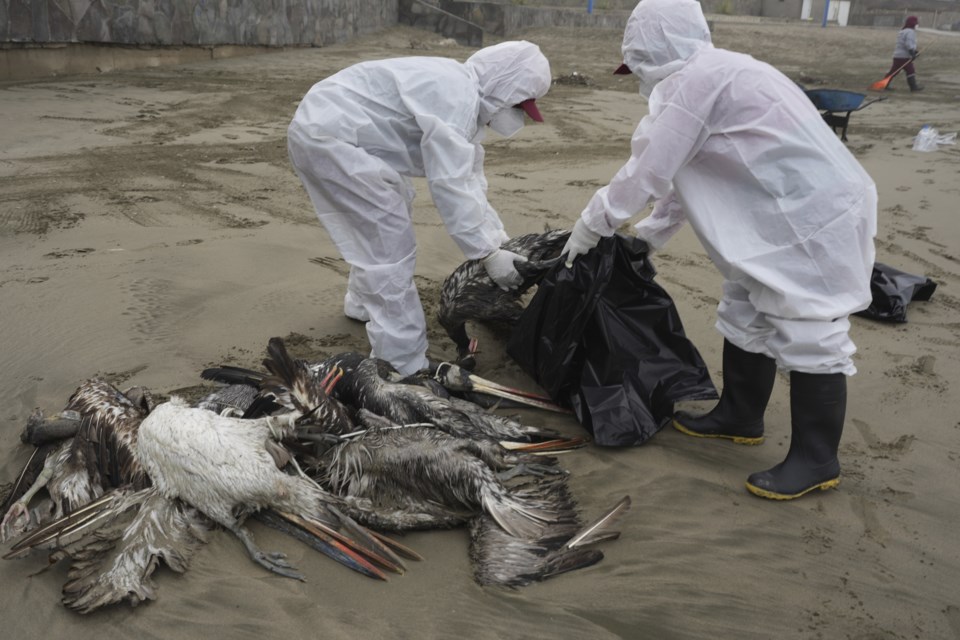NEW YORK (AP) — A recent bird flu outbreak at a mink farm has reignited worries about the virus spreading more broadly to people.
Scientists have been keeping tabs on this bird flu virus since the 1950s, though it wasn't deemed a threat to people until a 1997 outbreak in Hong Kong among visitors to live poultry markets.
As bird flu hits more and varied animals, like at the mink farm, the fear is that the virus could evolve to spread more easily between people, and potentially trigger a pandemic.
Scientist say another kind of bird flu was likely behind the devastating 1918-1919 flu pandemic, and avian viruses played roles in other flu pandemics in 1957, 1968, and 2009.
Still, the risk to the general public now is low, says Dr. Tim Uyeki of the U.S. Centers for Disease Control and Prevention.
A look at the bird flu virus and why it is getting renewed attention:
WHAT IS BIRD FLU?
Some flu viruses mainly affect people, but some others chiefly occur in animals. For example, there are flus that occur in dogs, plus pig — or swine — flu viruses. And then there are avian viruses that spread naturally in wild aquatic birds like ducks and geese, and then to chickens and other domesticated poultry.
The bird flu virus drawing attention today — Type A H5N1 — was first identified in 1959, by investigators looking into a flu outbreak in chickens in Scotland. Like other viruses, it has evolved over time, spawning newer versions of itself.
By 2007, the virus was found in more than 60 countries. In the U.S., it has recently been detected in wild birds in every state, as well as in commercial poultry operations or backyard flocks in 47 states. Since the beginning of last year, tens of millions of chickens have died of the virus or been killed to stop outbreaks from spreading, one of the reasons cited for soaring egg prices.
HOW OFTEN DO PEOPLE GET BIRD FLU?
The Hong Kong outbreak in 1997 was the first time this bird flu was blamed for severe human illness. Out of 18 people infected, six died. To contain the outbreak, the Hong Kong government closed live poultry markets, killed all the birds in the markets, and stopped bringing in chickens from southern China. It worked, for a while.
Symptoms are the similar to that of other flus, including cough, body aches and fever. Some people don't have noticeable symptoms, but some develop severe. life-threatening pneumonia.
Globally, nearly 870 human infections and 457 deaths have been reported to the World Health Organization in 20 countries. But the pace has slowed and there have been about 170 infections and 50 deaths in the last seven years. In the vast majority of cases, the infected people got it directly from infected birds.
The first and only U.S. case occurred just last April. A prison inmate in a work program picked it up while killing infected birds at a poultry farm in Montrose County, Colorado, in the western part of the state. His only symptom was fatigue and he recovered.
CAN IT SPREAD BETWEEN PEOPLE?
In some instances, investigators concluded that the bird flu virus apparently did spread from one person to another. That happened in Thailand, Vietnam, Indonesia, China and Pakistan, most recently in 2007.
In each cluster, it spread within families from a sick person in the home. Scientists do not believe it can spread easily through casual contact, as seasonal flu can. But viruses mutate and change. Scientists worry about the ever-increasing number of opportunities for bird flu to mix with other flu viruses in infected people or animals and mutate, making it easier to spread to people.
It wouldn't take much for that to happen "and then we would be in a really tough situation,” said Dr. Luis Ostrosky, chief of infectious diseases and epidemiology at University of Texas Health Science Center at Houston.
The CDC's Uyeki said the most worried he's been about H5N1 was during the earlier clusters. That kind of human-to-human spread does not appear to be happening right now, he said.
WHAT HAPPENED AT THE MINK FARM?
Recent concern among public health experts has been fueled, in part, by detection of infections in a variety of mammals. The growing list includes foxes, raccoons, skunks, bears and even marine mammals like seals and porpoises. Officials in Peru said three sea lions found dead in November tested positive for, and the recent deaths of hundreds of others may be due to bird flu.
Then last month, a European medical journal reported on a bird flu outbreak in October at a mink farm in Spain with nearly 52,000 animals, where the illness spread like wildfire.
The mink were fed poultry, and wild birds in the region had been found to have bird flu. But researchers said that however it started, they believe the virus then spread from mink to mink — a worrisome scenario. No workers were infected, though they wore masks as part of COVID-19 precautions.
Jennifer Nuzzo, director of the Pandemic Center at Brown University School of Public Health, said the outbreak virus is being watched for mutations that could make it more easily transmitted to people, and potentially between people.
"That's the real worry," said Nuzzo.
___
The Associated Press Health and Science Department receives support from the Howard Hughes Medical Institute’s Science and Educational Media Group. The AP is solely responsible for all content.
Mike Stobbe, The Associated Press



